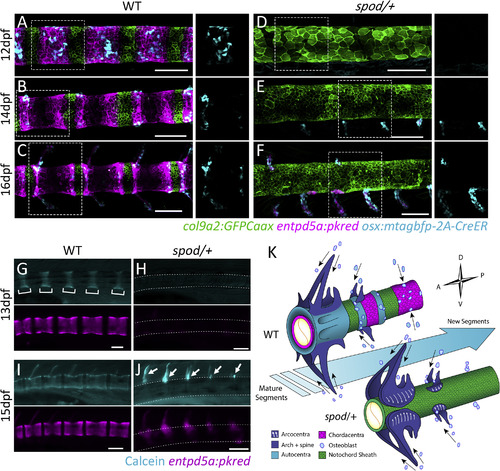
The spod Mutation Results in a Developmental Shift in Centra Patterning and Enhanced Osteoblast Contribution to Arcualia/Spines (A) Following notochord segmentation in wild-type zebrafish, sclerotomal osteoblasts are recruited to the mineralizing domains of the notochord sheath and overlay the chordacentra. (B and C) Osteoblasts anchor dorsally and ventrally on each mineralizing domain (B) and establish growth sites for the neural and hemal arches (C). (D) Notochord sheath cells are irregular and do not differentiate into mineralizing cells of the chordacentra in spondo mutants. (E) Osteoblasts prematurely migrate to focal points on the notochord sheath that will form the arches. (F) Osteoblasts never migrate to centra domains and only contribute to neural and hemal arcualia. Insets represent regions outlined by the dotted lines in which the blue channel (osteoblasts) has been isolated. (G–J) Live calcein staining of the same wild-type and spondo mutant fish imaged over time. (G and I) Chordacentra mineralize from the center of the entpd5a positive domain outward in wild-type fish. (I) Arches are ossified after the centra. (H and J) spondo mutants fail to form mineralized chordacentra. Ossification only occurs in the arches to which osteoblasts have been recruited. (K) Hypothesis of osteoblast migration patterns and their relationship to notochord segmentation. Arrows represent migratory paths. In wild-type fish, notochord segmentation guides osteoblast migratory patterns to form the final vertebral body structure. Subsequently, osteoblasts rely on cues from somite segmentation and migrate along segment boundaries to form vertebral arches. In spondo mutants, where notochord segmentation does not occur, osteoblasts fail to migrate to form centra structures. Osteoblasts solely migrate along somite segment boundaries to form vertebral arches. Hemicentra form as osteoblasts secrete osteoid matrix in regions of arch attachment and spill over to form partial centra (arcocentra extensions), closely resembling the basal condition of all Osteichthyes including early sarcopterygians lineages that lead to tetrapods.
|

